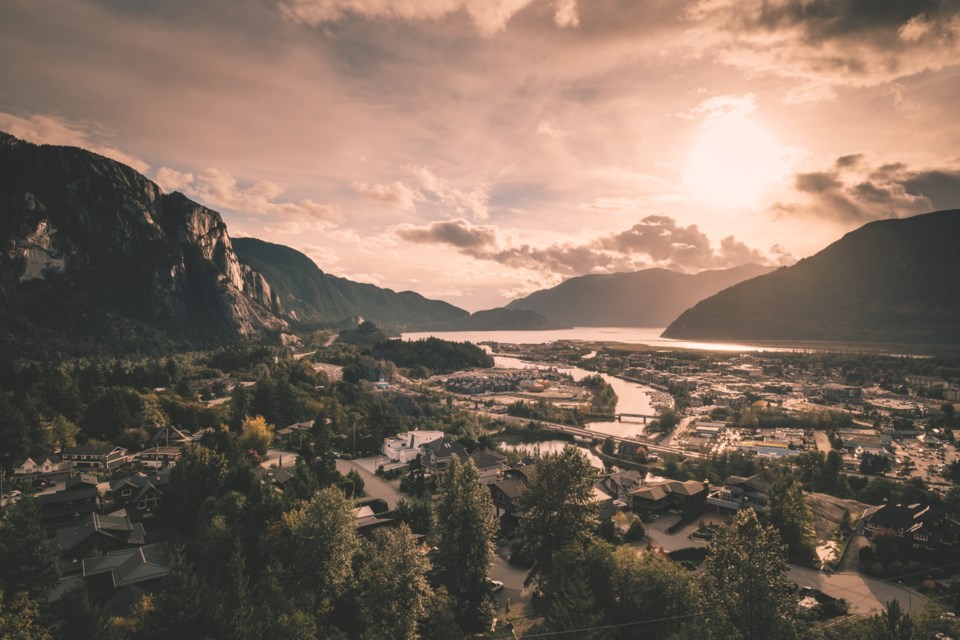Whenever I make the drive to Whistler after being away, I’m not back in the ’hood’ until I hit Horseshoe Bay and see Howe Sound. I’ve contemplated this majestic indentation on many occasions, even beginning a recent book with a blue-sky trip along the highway that limns it, describing the water, as I’ve always imagined it, shimmering “like a clinquant carpet.”
Although I always appreciated Howe Sound, I didn’t know much about it. Working on the Fire & Ice Aspiring UNESCO Geopark project, however, I’ve learned more of its geology—how it was carved by a lobe of the Cordilleran ice sheet during the height of the last Pleistocene glaciation; how the Porteau Cove Sill, sitting some 30 metres under the water’s surface, represents the terminal moraine of that glacier; how the copper mine at Britannia Beach was once the largest in the British Commonwealth; how a scatter of remnant volcanic vents can still be found along its northern reaches; and how the Stawamus Chief, a Cretaceous granitic pluton formed some 20 kilometres below the Earth’s surface, was eventually exposed through the dual processes of tectonic uplift and downward erosion.
So it was with these rocks in my head that I recently began work on a feature for British Columbia magazine about the newly designated Átl’ka7tsem/Howe Sound UNESCO World Biosphere Region. My research brought a lot more into focus, including the First Nations, colonial and natural histories of the area.
To begin, of course, none of what Europeans “discovered” about Howe Sound was news to the Squamish or Shishalh First Nations whose villages had flourished along these shores since time immemorial. Yet the Euros still managed to do a halting, ham-fisted job of figuring it out for themselves before wrecking the place.
In early July of 1791, during a first exploration of the Salish Sea, Spanish naval officer José María Narváez piloted his 10-metre schooner, Santa Saturnina, north through the Strait of Georgia past a large delta (this would be the Fraser). Tacking far offshore to avoid sandbars and cross-currents from the debouching river, he anchored off what’s today known as Point Grey, where Musqueam canoes soon arrived to trade. Departing, he entered Burrard Inlet, the harbour Vancouver would eventually coalesce around, but penetrated only as far as English Bay. Heading north again, he picked his way through a scatter of islands occupying an even larger break in the precipitous shoreline palisade. Eschewing another inlet to go ashore on the Sunshine Coast, he nevertheless liked what he’d seen, inking it in as Bocas del Carmelo—“mouths of abundance”—on his chart.
The following summer intrepid British explorer Captain George Vancouver would fully survey the Bocas, discovering how its islands occupied a funnel-shaped area (the virtual definition of “sound” to British navigators) before narrowing to a lengthy fjord. With typical colonial hubris, he named it after fellow naval officer Richard Scrope, a.k.a. Lord Admiral Earl Howe. Travelling that time of year, both he and Narváez may have seen grey or humpback whales surfacing, orcas chasing salmon, dolphins or seals, rock islets coated in lazing sea lions, sea otters floating on kelp mats, and everywhere scarlet ribbons of sockeye heading into coastal rivers to spawn—a plentitude neither could have imagined would be wiped out in a century, then take another century to even begin to reestablish.
Though it would lose entirely some of its iconic megafauna to overhunting, overfishing and the food-chain ravages of industrial pollution from mines and paper mills as Vancouver burgeoned into a city of 2.5 million, Howe Sound nevertheless remained relatively wild for such a near-urban enclave. The fact that it’s still a place of fragile abundance and teetering beauty underscores the need for everyone who depends on it to work together to protect and enjoy it in a sustainable manner—the very reason behind the Biosphere Region designation.
“We’ve seen a shift toward tourism and recreation and many more people visiting the region,” said Ruth Simons after shepherding the initiative to a successful completion through a five-year process. “Going forward there will be an emphasis on ensuring we’re conserving and protecting sensitive ecological areas and habitat so we don’t suffer any more biodiversity loss.”
Jessica Shultz, a PhD candidate in marine biodiversity at the University of Guelph who was also involved, outlines the strong biological arguments for protecting Howe Sound. “Over 700 species of marine animals live there. That’s representative of other coastal areas but the biosphere region is one way we can call attention to them. Relatively speaking, it’s easier to take care of more remote wildernesses, so the fact this one is used for activities that range from industrial to recreational to food harvesting make managing threats to its integrity a huge task. The work that needs to be done is finding a sustainable approach to all these.”
Underpinning the sound’s biodiversity are its several special habitats. “These waters are important for forage fish that feed whales and salmon. Eel grass beds offer important nursery habitat for salmon and rockfish, provide a storm buffer and are important for climate change because they’re so efficient at transferring carbon into the sediments,” says Schultz. “And the 18 or so glass sponge reefs that have been discovered? Well, they’re a cornerstone for conservation and biological diversity, creating habitat for other creatures.”
Bonus factoid: as it turns out, glass sponge reefs require two things to get started: bottom areas of low sedimentation—like the kind of towering substrates plowed up by glaciers; and high levels of dissolved silica—the kind an abundance of upstream volcanic rock delivers daily to the sound.
How’s that for circling back to the rocks in my head?
Leslie Anthony is a biologist, writer and author of several popular books on environmental science.




